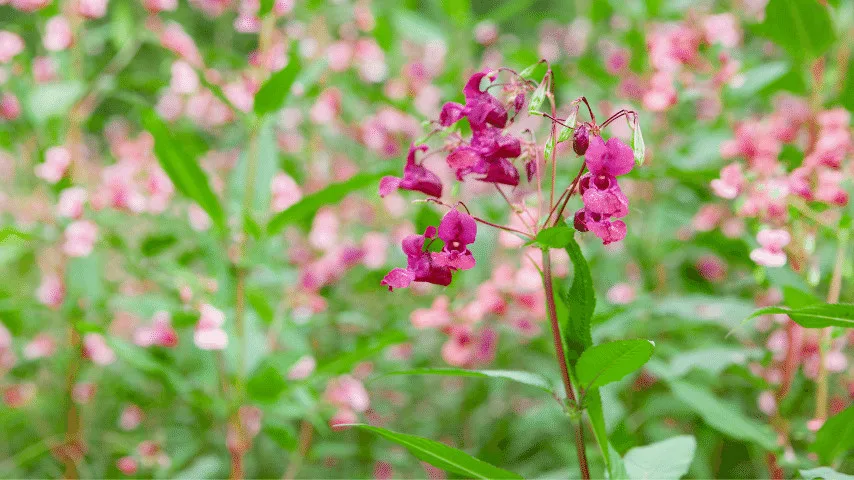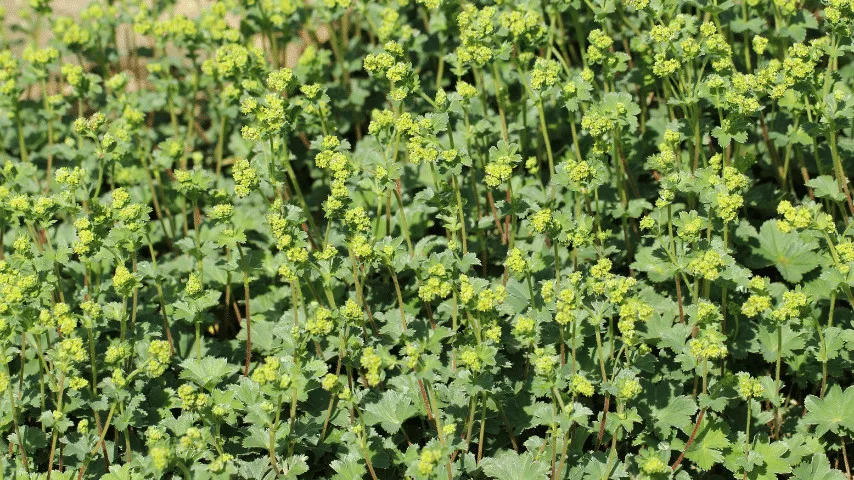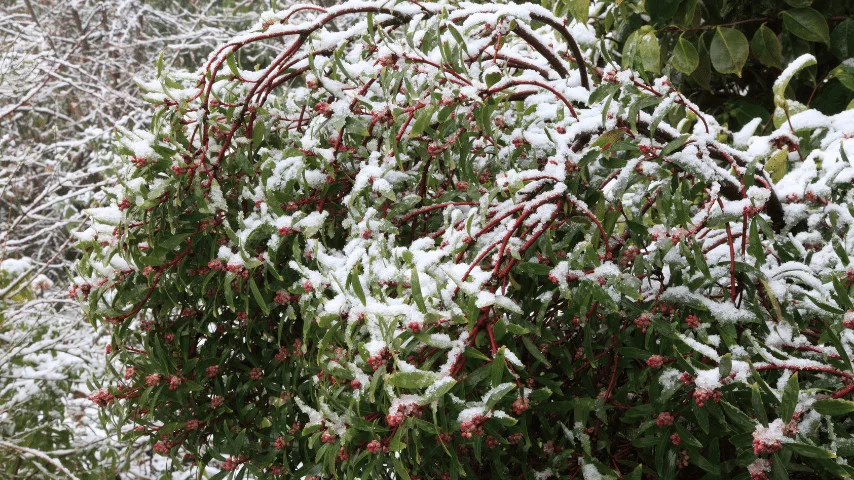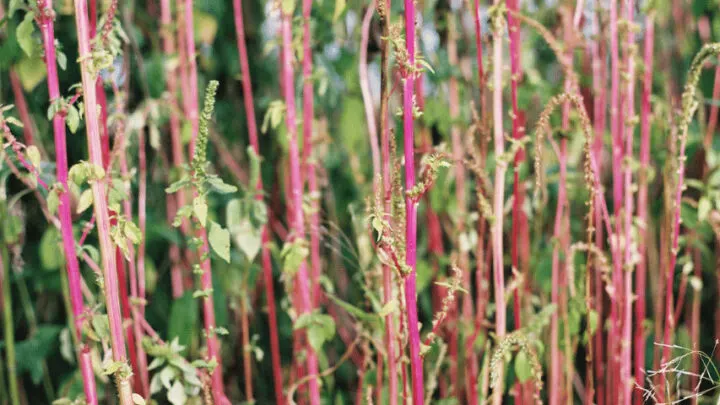Plants with red stems are common in houseplants and the wild. The stems come in different shades of red and add beauty to the plant.
The red shade can be seen on the whole branch or sometimes partially.
Some plants have genetically red stems, while other plants may change their stem color due to weather conditions, stress, or light intensity.
Some plants with red stems give edible fruit, some are harmful to humans, whereas others are not.
So, it is essential to identify them before storing them in your home.
In some plants, the red stems appear only during particular weather. In contrast, other plants have red stems throughout the year.
Table of Contents
10 Plants with Red Stems
Having a red stem is a peculiar feature that makes it simple to spot them. Some of the most common plants with red stems are:
- Pokeweed (Phytolacca americana)
- Elephant Bush (Portulacaria afra)
- Himalayan Balsam (Impatiens glandulifera)
- Wine Berry (Rubus phoenicolasius)
- Lady’s Mantle (Alchemilla)
- Common Purslane (Portulaca oleracea)
- Castor Bean (Ricinus communis)
- Mountain Pepper (Tasmannia lanceolata)
- Peonies (Paeonia spp.)
- Pigweed (Amaranthus)

10 Plants with Red Stems
Looking Deeper into 10 Plants with Red Stems
Each of these plants has specific and distinct features with different leaves and foliage to help you identify them.
Most of these plants give fruit, making them even better for planting in your gardens.
Their bright and striking red appearance adds beauty to the place they are planted in.
Following are the basic plant care requirement of these plants:
1. Pokeweed
Pokeweed is a hardy herb grown mostly in warm climates. It can be an invasive weed for those who didn’t plant it.
The botanical name of pokeweed is Phytolacca americana and it is native to North America according to the University of Florida.
But some people prefer to grow pokeweed in their gardens for the berries it produces.
These berries make a common salad known as ‘poke sallet.’
Some pokeberries are toxic to humans and can cause an allergic reaction.
These plants have heart-shaped leaves which can grow up to 6 to 12 inches and gives beautiful white flowers during the summer.
Poke berries grow best in warm climates with high temperatures and full sun.
They require moist but well-drained soil with a pH ranging from 4.7 to 8.0.
These plants can withstand a broad range of humidity conditions and grow in partial shade.
They don’t need fertilizer as long as the planting mix is fertilized.
Under ideal conditions, the plant may reach a height of 12 feet and a width of 6 feet.
Refrain from eating older pokeberries because the older the plant gets, the more toxic it becomes.
Plant a new plant every year if you want to eat the pokeberries.
2. Elephant Bush

Elephant Bush is a beautiful plant with its red thick stems and green leaves
Elephant bush, scientifically known as Portulacaria afra, is a fleshy, succulent plant that thrives in dry environments and is a low-maintenance plant.
It resembles jade plants because of its thick stems and green leaves.
It requires direct sunlight for 6 hours a day. The plant dislikes winter and cannot tolerate frost.
The temperature should be within 70 and 85 degrees Fahrenheit (21 and 29 degrees Celsius).
The humidity level should be in the range of 30% to 50%.
It requires well-drained soil with sand, vermiculite, or pumice with a pH range of 5.6 to 6.5.
It requires low to moderate watering and Can be grown both inside and outside of your home.
3. Himalayan Balsam

Himalayan Balsam grows a beautiful flower with red stems that usually grows in damp environments
Himalayan Balsam, scientifically known as Impatiens glandulifera is a non-invasive plant that usually grows around damp environments.
It enjoys tropical temperatures, but it grows best in full sunshine or mild shade.
These plants require moderate temperatures ranging from 60–77°F (15–25°C) and high humidity.
It usually grows in damp places and can tolerate various environmental conditions. However, it cannot tolerate frost and droughts.
The soil should be rich, moist soil with lots of nutrients with a wide pH range of 3.5 to 7.7.
4. Wine Berry (Rubus phoenicolasius)

Wine Berry is a beautiful plant with red stems that produce delicious fruit
Wineberry, a Japanese plant closely related to raspberry and blackberries, is a beautiful plant with red stems that produce delicious fruit.
It grows best in forests and moist environments with enough sunlight. For optimal development, it requires full sun or moderate shade.
These plants require high humidity and a temperature range of 60–68°F (15–20°C).
The soil should be loam soil that is completely drained and rich. Soil pH should be between 6.0 and 8.0.
5. Lady’s Mantle (Alchemilla)

Lady’s Mantle is a low-maintenance plant with semi-round, scalloped-shaped leaves and red and green stems
The plant Lady’s Mantle is a perennial that grows in late spring and early summer.
It is a low-maintenance plant with semi-round, scalloped-shaped leaves.
It grows best in cool summers with moist, fertile soil and shady locations.
It grows well in full sun but prefers shade in warm weather.
Fertilizing is not necessary, and watering is only required if the weather is really hot.
The plant requires pruning and cannot tolerate frost. Hence, it should be placed indoors during the frost season.
6. Common Purslane (Portulaca oleracea)

Common Purslane grows a beautiful flower with green and red stems
Common purslane is a succulent plant that thrives in dry environments. They grow best in warm weather with full sun.
Shade is not for some plants. These plants may grow in a wide range of soil types.
But the ideal soil for common purslane is dry soil on which the seeds are scattered. It is not necessary to bury or cover the seeds with soil.
70–100°F (21–37°C) is the ideal temperature range, with the soil pH between 5.5 to 7.5
7. Castor Bean

Castor Bean (Ricinus communis)
Scientifically known as Ricinus communis, castor bean is an herbaceous plant,
typically categorized as a weed with large leaves resembling a ‘European Tick’. It grows best in tropical and frost-free climates.
50 – 64°F (10 – 18°C) is the ideal temperature for seed germination. 68 – 79°F (20 – 26°C) is the adequate daily temperature for best growth.
It requires well-drained but moist soil, which should be rich in nutrients. It grows along riverbeds in hot climates and requires full sun for 8 hours a day.
If the temperature falls under 32°F (0°C), the plant will die. The plant can grow up to 40 feet tall with woody stems and produces fruit.
They require plenty of water and fertilizer to grow. Putting a lot of organic material such as compost before planting the seeds.
The plant prefers hot and humid conditions. These plants are toxic for humans if eaten directly and can cause allergic reactions upon touching.
The fruit from castor bean should not be consumed directly, but castor oil can be extracted from the plant, which is very beneficial and has medicinal benefits.
8. Mountain Pepper (Tasmannia lanceolata)

Mountain Pepper (Tasmannia lanceolata)
Mountain pepper is an evergreen shrub known for its green leaves and vibrant red stems.
It has scented leaves that are used to make many essential oils. During the winter, it also yields fruit.
The plant is low-maintenance and grows up to 13 feet tall in warm regions.
It requires well-drained soil with acidic to neutral pH, and the male and female plants should be planted side by side for proper germination.
9. Peonies

Peonies (Paeonia spp.) are beautiful flowering plants with red stems
Peonies are beautiful flowering plants with red stems. They require sunny climates and well-drained soil for optimal growth.
They also require good air circulation. Peonies are easy-to-grow plants that produce excellent blooms in your garden and enhance its beauty.
They should be kept carefully because they are prone to fungal diseases.
10. Pigweed

Pigweed (Amaranthus) grows a beautiful flower with red stems
Redroot pigweed is categorized as a tall invasive weed that can grow up to 6 feet tall.
It is scientifically known as Amaranthus and has a diamond or oval-shaped leaves. It is an easy-to-grow, edible, flowering plant for a vegetable garden.
It grows in temperatures ranging from 85 – 95°F (29–35°C). It prefers hot climates with exposure to full sun daily. It can also grow in partial shade.
Pigweed requires rich, compact, and fertile soil because the seeds need more moisture for germination. The soil pH should be between 4.7 to 6.3.
The plants come in different colors like pink, white, and lavender, and their bright flowers attract pollination agents like butterflies.
They require fertilizer one or two times a season and need watering. They are drought tolerant but water them twice weekly in dry conditions.
Read about Russelia Plant Care next.
Frequently Asked Questions About 10 Plants with Red Stems
Why are my peonies turning red?
Too much sun exposure or fungal diseases can cause the peony leaves to turn red.
Is pokeweed toxic?
Pokeweed is hazardous to humans and can trigger allergic responses. So, it’s best to boil it before using it for salads.
Is pigweed edible?
The seeds of pigweed contain vitamin A and C along with proteins and fibers. The seeds can be cooked, roasted, or eaten raw.



